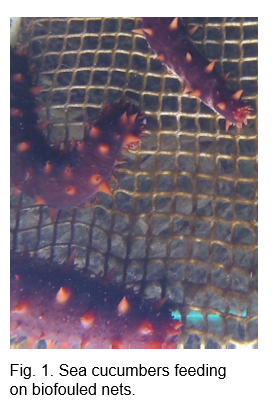BIOLOGICAL BIOFOULING CONTROL OF SALMON NET PENS USING THE GIANT RED SEA CUCUMBER Apostichopus californicus
Biofouling of aquaculture infrastructure is a universal challenge faced by both shellfish and finfish growers. Biofouling organisms such as algae, tunicates, sponges, hydroids, and mussels can add significant weight to nets and cages, which must be regularly cleaned to maintain optimal water flow and integrity of these structures. The need to regularly clean biofouling is a time consuming and often expensive process that can be a constraint to industry. Modern cleaning techniques are highly variable and range from direct infrastructure swapping to industrialized power washing that uses high-pressure water to remove the biofouling. The latter is a popular technique in the finfish industry due to its efficacy of removing biofouling, but it is time consuming, costly, and may have negative fish-gill-health consequences that are just being recognized. Development of alternative practices to prevent and control biofouling in finfish net pens is therefore warranted to help offset the time, financial, and potential fish-health costs of current cleaning technologies.
Sea cucumbers like Apostichopus californicus have long been recognized for their co-culture potential due to their natural ability to recycle organic-rich sediments into nutrient poor faeces, but little research has examined their ability to control biofouling. We tested the ability of A. californicus to consume biofouling material on nets at two organic Chinook (Oncorhynchus tshawytscha) farm sites using four treatments: pens with (1) fish and sea cucumbers (SC); (2) fish, but no SC; (3) no fish, but SC; and (4) no fish and no SC. Sea cucumbers were observed feeding on biofouling organisms on the nets in treatment 3 and preferentially consuming excess feed / salmon wastes in treatment 1. Gut-content analysis and biochemical profiles of the sea cucumbers were conducted for treatments 1 and 3. No negative interactions (e.g. health and/or behavioural) were detected between the salmon and the sea cucumbers suggesting that this is a good partnership to explore further.
